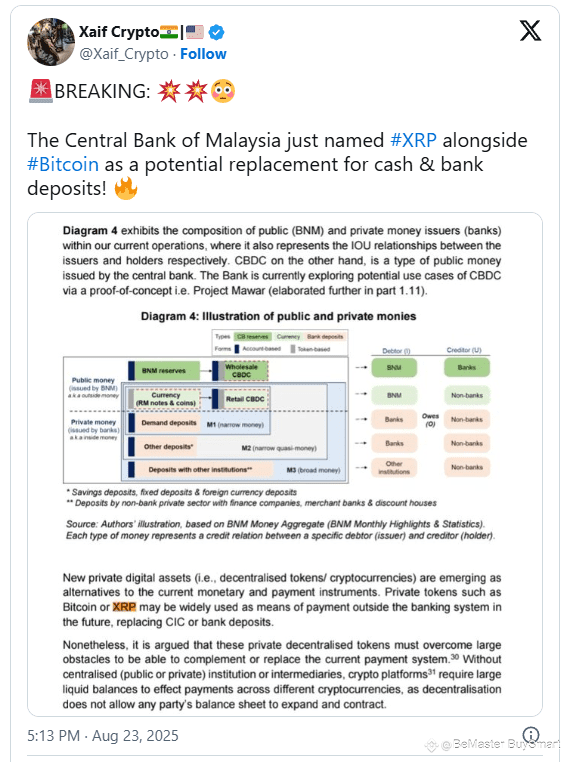$XRP Crypto analyst and investor Xaif published a tweet stating that the Central Bank of Malaysia had named XRP alongside Bitcoin as a potential replacement for cash and bank deposits.
The post was presented as breaking news and underscored the significance of both assets being specifically mentioned in an official central bank document.
Xaif highlighted this reference as noteworthy because it placed XRP and Bitcoin together in the context of possible future roles as payment instruments outside of traditional banking structures.

✨Details from the Attached Document
The image accompanying the tweet features an excerpt from a Bank Negara Malaysia document, which contains a diagram titled “Illustration of Public and Private Monies.” The diagram categorizes public money, such as central bank reserves, currency, and potential central bank digital currencies, alongside private money, which includes bank deposits and other institutional deposits.
It further links these to monetary aggregates such as M1, M2, and M3, while illustrating debtor-creditor relationships between the central bank, banks, non-banks, and other institutions. The document also mentions Project Mawar, a proof-of-concept initiative through which the bank is currently exploring the potential use cases of central bank digital currency.
Beneath the diagram, a passage directly addresses the emergence of new private digital assets. These are described as decentralized tokens or cryptocurrencies that could serve as alternatives to current monetary and payment instruments.
In this context, the document explicitly names Bitcoin and XRP, stating that such private tokens may in the future be widely used as a means of payment outside the banking system. It adds that they could replace cash in circulation or bank deposits if adopted at scale.
✨Importance of XRP and Bitcoin Reference
Xaif’s tweet draws attention to the fact that the Malaysian central bank explicitly lists XRP and Bitcoin in this context. The mention places both assets in the same category of potential alternatives to traditional money.
By highlighting this, Xaif interprets the document as recognition of their possible future role in payments and settlement, separate from the framework of central bank-issued or bank-issued money. The inclusion of XRP, in particular, underscores its ongoing relevance in institutional and regulatory discussions about digital assets.
✨Broader Context and Limitations
While the document names XRP and Bitcoin as possible replacements for cash and deposits, it also outlines challenges for such a scenario to materialize. It states that private decentralized tokens must overcome significant barriers to complement or substitute the current payment system.
Without centralized intermediaries, these platforms would require large liquidity balances to enable efficient settlement across different cryptocurrencies. The text makes it clear that decentralization introduces obstacles that do not exist in systems managed by central banks or regulated financial institutions.
🚀🚀🚀 FOLLOW BE_MASTER BUY_SMART 💰💰💰
Appreciate the work. 😍 Thank You. 👍 FOLLOW BeMaster BuySmart 🚀 TO FIND OUT MORE $$$$$ 🤩 BE MASTER BUY SMART 💰🤩
🚀🚀🚀 NOT JUST LIKE BUT, CLICK FOLLOW BE MASTER BUY SMART - Thank You.

